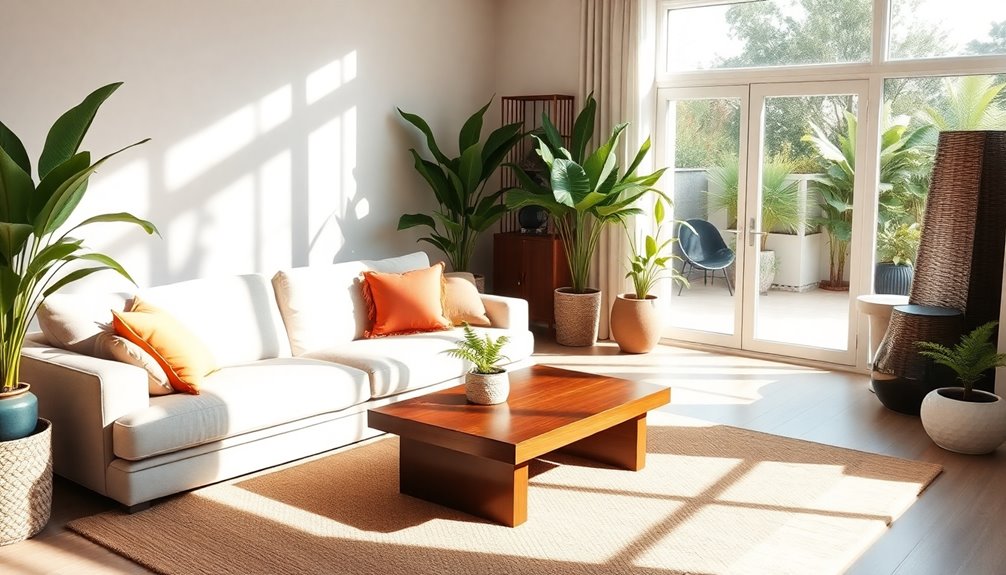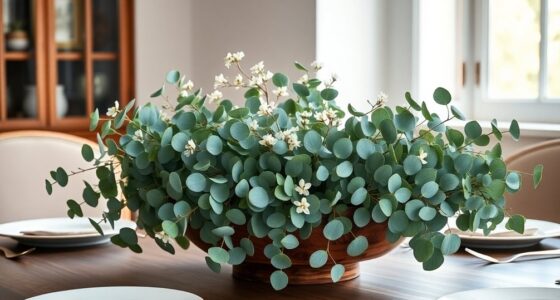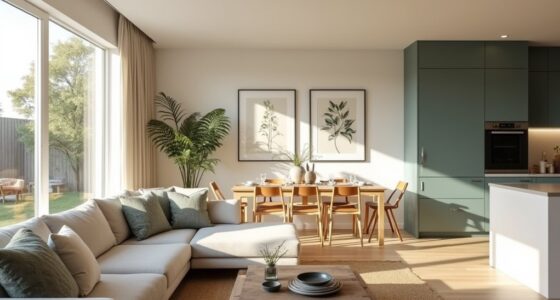To harmonize your spaces with Feng Shui design, focus on optimizing energy flow and balancing essential elements. Start by decluttering to allow Chi, or life force, to flow freely, keeping pathways clear and furniture in a commanding position. Integrate the five elements—wood, fire, earth, metal, and water—through color choices and natural accents to enhance overall well-being. Utilize a Bagua map to align each room with specific life areas. Incorporate natural light and create zones for relaxation and productivity to support harmony. There's much more to discover, so explore additional tips to create your balanced sanctuary.
Key Takeaways
- Position furniture in a commanding position to enhance security and focus while allowing for a clear view of the entrance.
- Utilize the Bagua energy map to align rooms with specific life areas, incorporating the five elements for balance.
- Maintain a clutter-free environment by regularly evaluating belongings and designating zones for essential items to promote positive energy.
- Incorporate natural elements like plants and water features to enhance tranquility and improve air quality, fostering a connection to nature.
- Use a balanced color palette, combining calming and energizing hues, to create a harmonious atmosphere that supports relaxation and vitality.
Principles of Feng Shui
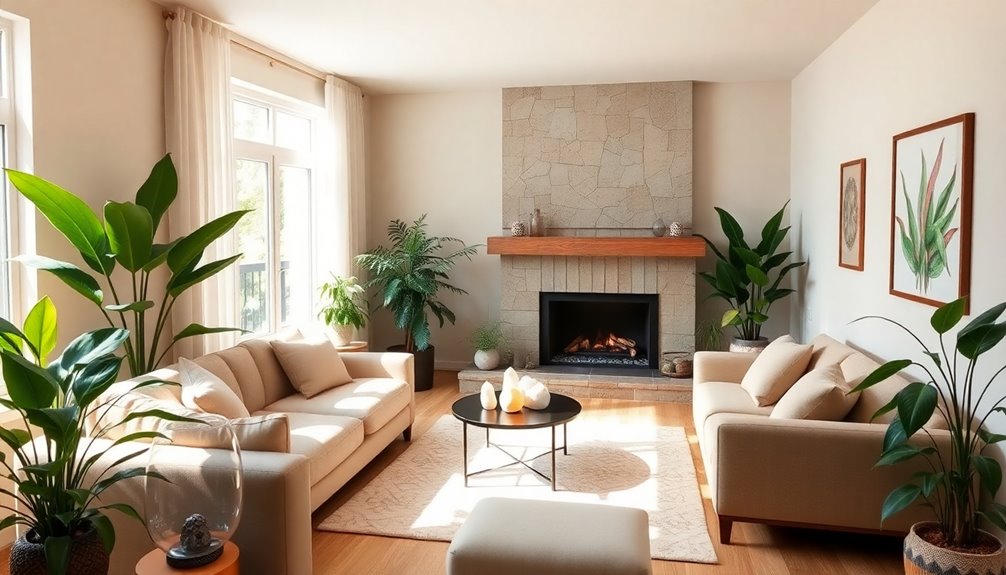
Understanding the principles of Feng Shui can transform your living space into a harmonious environment. The key is chi, the essential life force that must flow freely throughout your home.
To enhance energy flow, keep pathways clear and let natural light in by opening blinds. Be mindful of mirror placement; they should reflect light and views but not directly face doors.
Positioning is important, too. In each room, find the commanding position—usually farthest from the door—where you can see the entrance. This encourages security and focus. Additionally, maintaining a clutter-free environment is crucial for promoting positive energy and avoiding stagnation.
Finally, familiarize yourself with the Bagua energy map to align your rooms with specific life areas. Incorporating the five elements—earth, metal, water, wood, and fire—can further balance your space and nurture positive energy.
Decluttering and Organizing
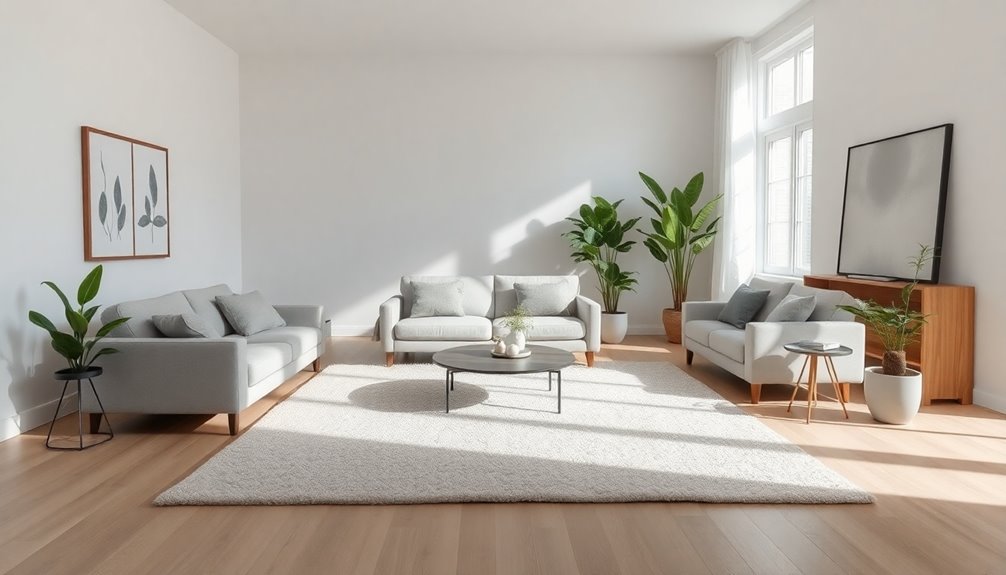
While decluttering and organizing your space may seem intimidating, it's crucial for creating a harmonious environment in line with Feng Shui principles.
Start with your entryway; clear obstacles and keep it clean to invite positive energy. Add greenery and guarantee good lighting to enhance liveliness. Clutter is viewed as detrimental to Chi energy flow, so addressing it promptly is essential.
Work room by room, sorting items into piles to keep, donate, or discard. Focus on clutter zones like drawers and closets to improve energy flow.
Evaluate the practicality and emotional impact of your belongings, removing anything broken or negative. Schedule regular decluttering sessions and make use of natural light to refresh the space.
Surround yourself with items that matter most, designating clutter-free zones to maintain an organized, balanced home. By focusing on quality over quantity, you can create a serene atmosphere that fosters relaxation and creativity. Incorporating minimalist interior design ideas can help streamline your space, emphasizing functionality while reducing distractions. This approach not only elevates the aesthetics of your home but also promotes a sense of peace and clarity in your daily life.
Balancing the Five Elements

To create a harmonious living space, balancing the five elements of Feng Shui is crucial.
Start by incorporating wood elements like plants or furniture in green and brown tones, especially in the east or southeast for health.
Add fire through red or orange accents, candles, or artwork in the south to spark energy.
Use earth tones such as beige and terracotta in the center to promote stability. Assessing dominance of elements in your space ensures that you are aware of which energies are prevalent and which need adjustment.
Introduce metal accents in white or gray, positioned in the west for clarity.
Finally, incorporate water features in deep blue or black in the north to enhance tranquility.
Regularly assess your space, adjusting elements to maintain balance and guarantee a positive energy flow throughout your home.
Enhancing Energy Flow
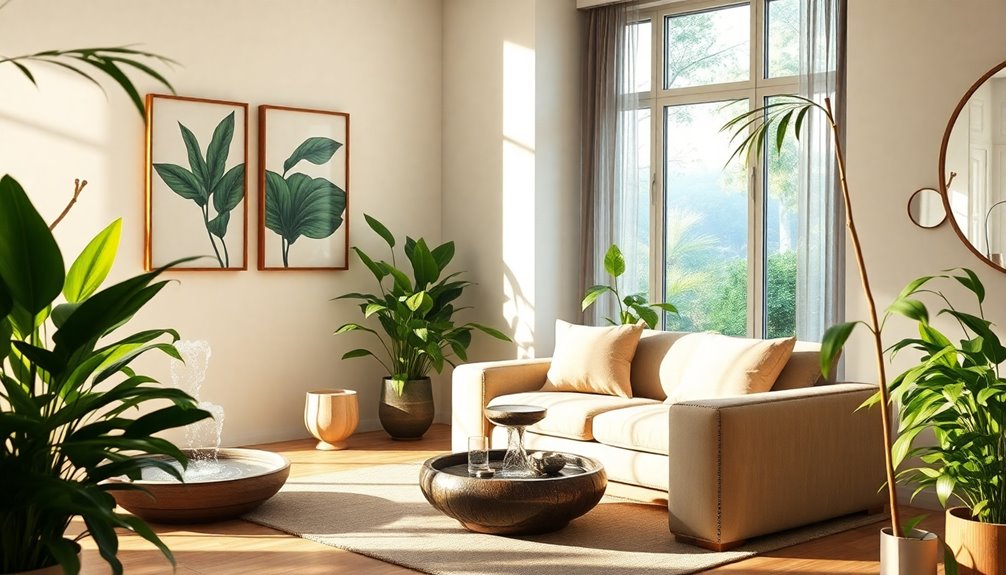
Enhancing energy flow in your space is essential for creating a balanced and harmonious environment.
Start by understanding the types of energy present—Chi, the positive energy, and Sha, the negative energy. Focus on maximizing Chi by decluttering your space and ensuring good air circulation.
Place furniture in a commanding position to foster a sense of control and security. Use mirrors to redirect positive energy and maintain symmetry in your layout.
Consider color selection; use hues like red for energy or blue for calmness, but avoid overwhelming the space with one color.
Finally, incorporate water elements strategically to promote tranquility and positive vibrations, ensuring they remain fresh and flowing.
Using the Bagua
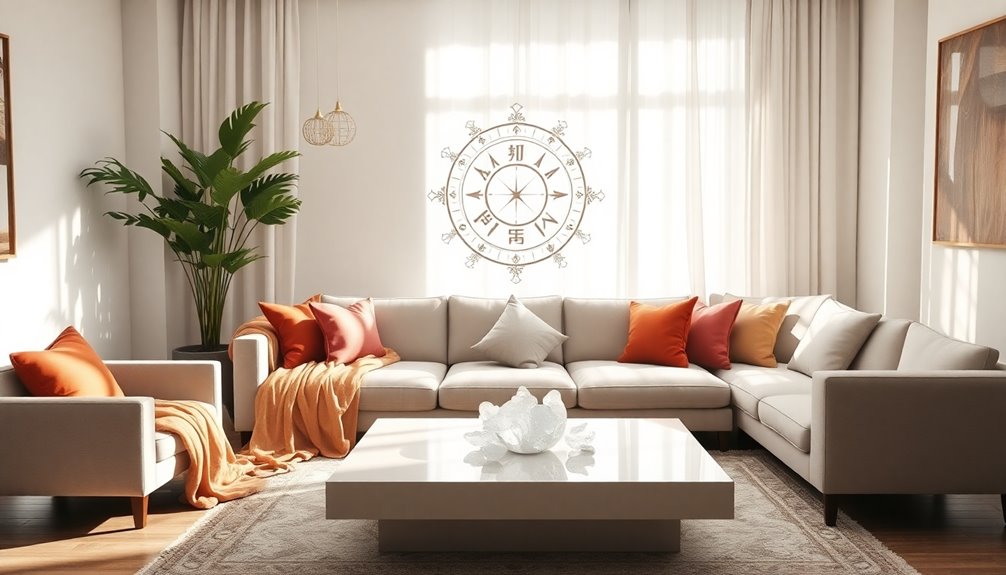
How can you effectively use the Bagua Map to transform your living or working space?
Start by aligning the map with your main entrance, positioning the bottom towards the door. This octagonal grid splits your space into nine areas, each linked to different life aspects like wealth, love, and career.
Identify which area corresponds to your goals, then enhance it with specific elements. For instance, use symbols of wealth in the Wealth and Prosperity area or pair objects in Love and Relationships to foster harmony. Incorporating the five elements into your enhancements can significantly improve the energy flow in each gua.
Regularly cleanse and declutter these spaces to maintain energy flow. Customize elements based on your aspirations to create a tailored Feng Shui experience that promotes balance and positivity throughout your environment.
Creating Harmony With Yin and Yang

The principles of the Bagua Map can set the foundation for creating a harmonious environment, but achieving balance between Yin and Yang takes your space to the next level.
Yin and Yang represent opposing forces that must coexist for ideal energy flow. You can create harmony by incorporating both elements—use soft, dark colors and quiet spaces for Yin, while introducing bright colors and open layouts for Yang. Balance between Yin and Yang is essential for prosperity and well-being, making it crucial to be mindful of the energy dynamics in your space.
Mix textures and materials to enhance this balance, and arrange furniture to allow easy movement. In specific rooms, like the living room, emphasize Yang with vibrant hues, while softening it with Yin through cozy furnishings.
Adjust your space seasonally to maintain this equilibrium, promoting health and happiness throughout your home.
Maximizing Natural Light
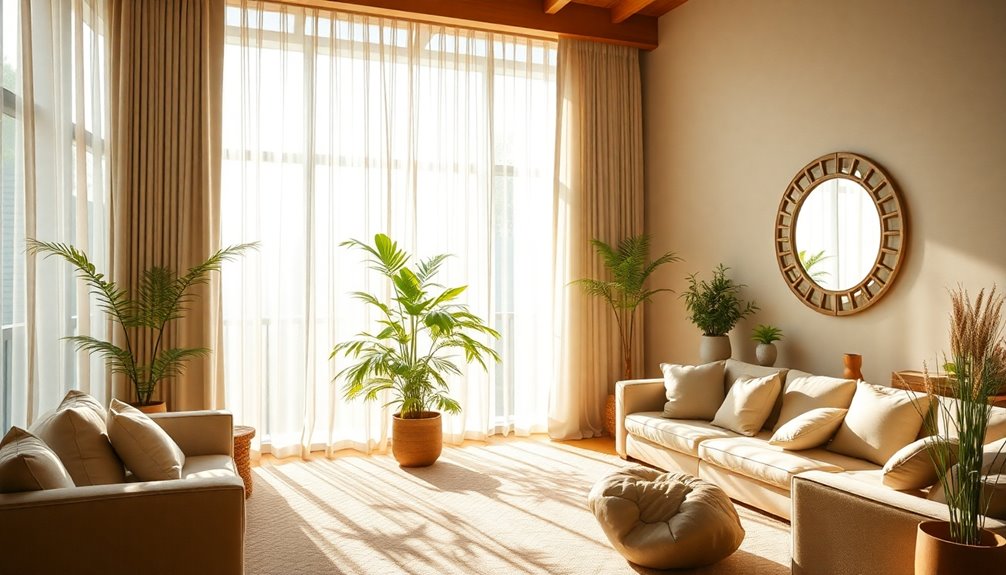
Natural light is crucial for creating a vibrant and uplifting atmosphere in your home. It enhances your well-being, boosts energy, and promotes a harmonious environment. To maximize natural light, make certain your windows are clean and unobstructed. Use sheer curtains or blinds to control light levels while still allowing sunlight to stream in.
Strategically place mirrors to reflect and amplify natural light, making spaces feel brighter and more open. Position mirrors at the end of hallways or opposite windows for best effect. Clean, unobstructed windows ensure that natural light flows freely into your home, further enhancing the positive energy throughout your spaces. Additionally, consider implementing efficient heat pump systems that can help maintain a comfortable indoor climate while utilizing natural light effectively.
Practical Feng Shui Tips
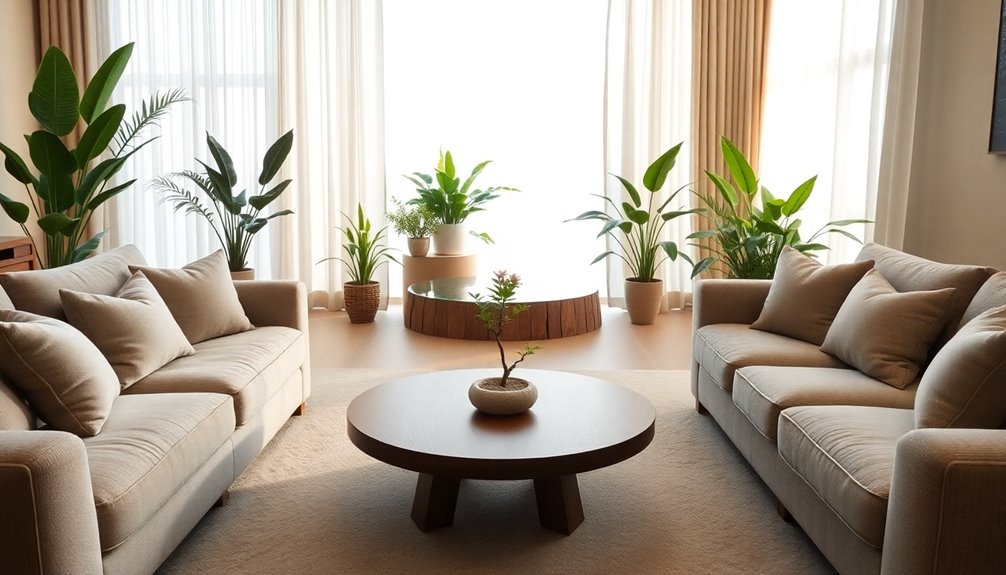
Maximizing natural light sets the stage for a harmonious home, but practical Feng Shui tips can further enhance the positive energy in your space.
Start by decluttering; remove unnecessary items to unblock the flow of Chi. Organize your belongings in designated spots and keep passageways clear. The practice of Feng Shui emphasizes that clearing clutter is essential for facilitating energy flow and eliminating stagnation. Additionally, creating seamless indoor-outdoor flow can promote tranquility and connection with nature.
Incorporate the five elements by using colors and shapes that represent earth, fire, metal, wood, and water. Arrange your furniture thoughtfully, placing it in a commanding position for a clear view of the entrance.
Use calming shades like blue and energizing colors like green and red in your decor. Finally, add natural elements like plants and symbolic items to nurture positive energy and attract good fortune.
Frequently Asked Questions
How Can I Incorporate Feng Shui in a Small Apartment?
To incorporate feng shui in your small apartment, start by optimizing your layout.
Position your furniture to create clear pathways, and use mirrors to give the illusion of more space.
Keep surfaces clutter-free and use multi-functional furniture.
Add plants for air purification and choose soothing colors like blue or green.
Finally, maximize natural light by keeping windows unobstructed and using sheer curtains to enhance the positive energy in your home.
What Colors Are Best for a Feng Shui Bedroom?
You might think colors don't matter much in a bedroom, but they can greatly impact your mood and energy.
For a Feng Shui bedroom, opt for neutral colors like warm beiges and cool blues to create a calming atmosphere.
Accent with greens for balance and liveliness. Incorporate yellow for optimism and warmth.
Is It Necessary to Hire a Feng Shui Consultant?
It's not absolutely necessary to hire a Feng Shui consultant, but doing so can be incredibly beneficial.
You'll gain professional expertise tailored to your unique space, ensuring you avoid common mistakes. A consultant's objective perspective helps identify overlooked issues, while their in-depth knowledge addresses the complex energy dynamics at play.
If you're serious about creating a harmonious environment, investing in a consultant can provide you with optimum results and personalized guidance.
Can Feng Shui Help Improve My Sleep Quality?
Yes, Feng Shui can definitely help improve your sleep quality.
By positioning your bed in a command position and ensuring it's against a solid wall, you create a sense of security.
Choose calming colors for your bedding and keep the space clutter-free to promote relaxation.
Avoid placing electronics and workspaces in your bedroom, as they can be distracting.
Finally, consider using soft lighting and blackout curtains for a peaceful atmosphere conducive to sleep.
How Often Should I Reevaluate My Space for Feng Shui?
You should reevaluate your space for Feng Shui regularly. Monthly check-ins help you assess energy shifts, while seasonal adjustments align your space with changing elements.
Aim for quarterly deep cleans to clear stagnant energy and an annual audit for overall balance. Pay attention to signs like family dynamics or health issues that may indicate a need for reevaluation.
Life changes also trigger the need to reassess your environment for continued support.
Conclusion
By embracing feng shui principles, you're not just rearranging furniture; you're crafting a symphony of energy in your home. As you declutter and balance the elements, you'll feel a revitalizing breeze of harmony sweep through your space. Let natural light dance in, and watch how the yin and yang of your surroundings transform into a sanctuary. With these practical tips, you're weaving a tapestry of peace and positivity, turning your home into a haven where balance thrives.
